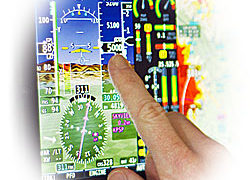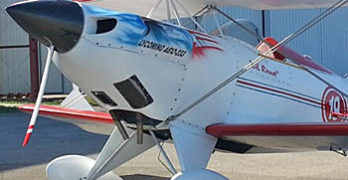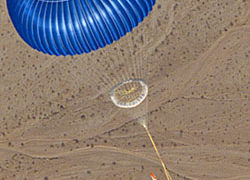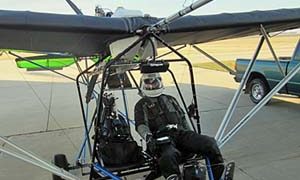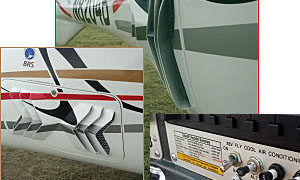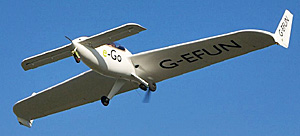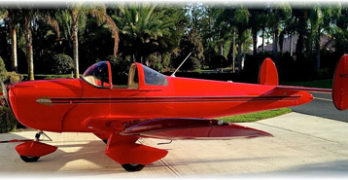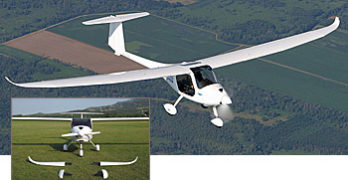I view Rans’ newest aircraft as a benchmark design for the airplane company based in Hays, Kansas, more than 100 miles northwest of another aviation hub known as Wichita. Rans started 31 years ago with a little single seat ultralight called Coyote. Company designer Randy Schlitter shows marketing savvy using both numbers and names for his models — they help people remember — so it was another benchmark of sorts when he hit 20, and that would be for the S-20 Raven. His designs don’t plod along with incremental changes. For example, his S-11 (never produced) was quite a radical departure and the S-19 Venterra that preceded the S-20 Raven was an all-metal low wing design. Raven isn’t anything like S-19 but it is a great deal like two other airplanes in the bulging portfolio of creations from Randy. You might think of it as a merging of two of the most successful models ever made by Rans.
Search Results for : CT AND hand control
Not finding exactly what you expected? Try our advanced search option.
Select a manufacturer to go straight to all our content about that manufacturer.
Select an aircraft model to go straight to all our content about that model.
Dynon’s Modernized SkyView Touch
With the chance to fly and learn both Dynon SkyView and Garmin 796, I have become a fan of each. Dynon is dominant in Light-Sport Aircraft instrument panels for very good reasons. They work well and don’t cost an arm and a leg. Their Synthetic Vision is superb. However, much as I have come to love those big, beautiful, all-color digital instruments, you must resort to a button or joystick to make changes. Those of us spoiled by our smartphones and iPads have become accustomed to touch. So, no wonder that I also fell in love with the all-touch 796. It works a lot like my iPad and finding things is reasonably easy … a few functions are hidden behind menu layers but on whole, the 796 is a brilliant bit of engineering design. However, in bumpy air, I’ve had to learn a technique of hanging a thumb or finger on the bezel to steady my hand as I try to select certain functions by touch.
Pilots, Start Your (LSA) Engines!
In aviation, one of our most noteworthy events is the Reno Air Races. Sadly, that longtime and much storied race series has an uncertain future due to leadership challenges and rising costs. While those organizers sort that out, here comes busy LSA entrepreneur Doc’ Bailey, who seems never to sit still for long. Doc’ is the man behind Renegade Light Sport Aircraft, builder of the Falcon (more on that at the end), the installation of Lycoming O-233 engine on various aircraft, the importer of the B.O.T. Super Cruiser and the D-Motor engine, and a participant in training wounded U.S. soldiers in hand-controlled Light-Sport Aircraft. His latest push is for SPAR, the Sport Pilot Air Races. Create a mental picture of the Red Bull Air Races but flown in powerful LSA or light kits and you’ll get the basic idea (albeit without the fantastic ad budget). SPAR organizers say the basic idea is a single aircraft being timed while running through a closed course (see nearby diagram).
BRS Moves Upward; Saves Those Moving Downward
For 18 years I worked with a great team at BRS Parachutes (as it was then called; they since renamed it to BRS Aerospace as they ventured into defense contracting). I left more than a decade ago and this website has since been my new home. I worked at BRS before parachutes were accepted and it was a great challenge and joy to help bring this life-saving product to market. The huge breakthrough that allowed BRS to gain the level of mainstream approval it enjoys today was one company: Cirrus Design. Co-founder Alan Klapmeier had lived through a mid-air collision and was determined his SR20 would have a whole-airframe parachute on it. While the ’20 and ’22 have much to speak for them, the models were distinguished in all of aviation by being “the parachute airplane.” Having a BRS system on board certainly helped and may have been one of the main reasons for the company’s success — with more than 4,000 aircraft sold in the last dozen or so years that are otherwise not aviation’s strongest period.
Quicksilver Near Special LSA Approval for Sport 2S
The Special Light-Sport Aircraft version of Quicksilver Aeronautics‘ popular Sport 2 model is completing efforts to gain FAA acceptance. An FAA audit is scheduled in December and the company announced it has completed the entire flight test regimen required to comply with ASTM industry consensus standards. A recent update to the standard now demands that a company must accumulate 100 hours of flight testing. Homebuilders expend some time to log the 40 hours required for an Experimental Amateur Built kit; this is two and half times as much. “We completed an entire ASTM Design & Performance standard test matrix,” said Daniel Perez, Chief Operations Officer for the California company. He also noted that those 100 flight hours involved 236 takeoffs and landings. These results follow a long period of other detailed testing and significant document preparation plus establishing the factory for repeatable, quality-controlled production of ready-to-fly aircraft.
Quiclsilver’s Sport 2S is a strutted, wide open cockpit, side-by-side two seater and will be the first Quicksilver aircraft to complete the entire compliance package.
Beetle Power in a Jaunty Jodel D9
“It is a truth universally acknowledged that a pilot not in possession of a good fortune will be in want of a VW-powered aircraft.” Well, I’m not entirely sure Jane Austen would’ve put it quite like that but one thing is irrefutable: If you want to fly an affordable aeroplane then it may well have a Beetle engine! And, here’s a very interesting factoid: the most produced aero-engine ever is probably Lycoming’s O-360, with around 250,000 made. However, Volkswagen made more than 21 million Beetle engines!
An interesting facet about lightweight taildraggers such as the D9 is that they have to be ‘flown’ all the time, even on the ground. Consequently even while taxiing I’m very aware of the wind, because even with differential braking turning out of wind can be a bit tricky. Of course, such simple machines have very simple checks, and while running through my generic SEP checks (which take the form of an unwritten ‘flow check’ around the cockpit), I often get the feeling (and particularly if I’ve flown something a bit more complex the day before) that I’ve forgotten something.
LSA Air; Jabiru Service; MGL XTreme; 90th Birthday
Cool It! — Scott Severen of US Aviation — the central Texas general aviation dynamo — is a man on a mission. He showed an AMT FlyCool installation (video) on a Flight Design CTLS at Sun ‘n Fun that was a surprisingly clean installation considering he brought all the air conditioning parts in his airline luggage. By AOPA’s fall Summit, he had refined it considerably (photo). Now the installation features a handsome louvered right side baggage door that brings fresh air in and exhausts warmer air. The panel switches are permanent and in the warm Texas sunshine, the system had great appeal. It adds surprisingly little weight (22 pounds); cost varies by installation but is much less expensive than old style air conditioning systems for airplanes. One downside is a loss of some luggage capacity but for example, a flight school wouldn’t care. Their students could chill instead of sweating through their flying lesson.
Deregulation Works & e-Go Easily Goes
In the last days of October, another fascinating UK light aircraft took to the air after several years in development. The brainchild of Giotto Castelli and Tony Bishop takes advantage of SSDR, a British CAA initiative with the longer name of “Single Seat Deregulation,” proving as has the LSA movement that reduced government control allows innovation to blossom. The British program allows aircraft weighing less than 115 kilograms to bypass conventional certification.
A test pilot took the canard design up for its first official flight recently logging about 30 minutes up to 4,000 feet and 80 knots to conduct initial handling trials. After a post-flight inspection, data analysis, and refueling, he took it up again for its second, one hour flight to explore the envelope further, including stability, control and canard stalls. Then on October 30th, with notoriously difficult UK weather still cooperating, former BAE Systems chief test pilot Keith Dennison demonstrated e-Go to an invited audience of customers, investors, volunteers, suppliers, friends and family at Tibenham airfield in Norfolk, England.
Sport Pilot-Eligible Ercoupes at Spruce Creek
Most of our attention is paid to either Light-Sport Aircraft, both SLSA and ELSA, or to light kit aircraft that Sport Pilots may fly. Yet another worthy category exists: Standard Category certified airplanes that can also be flown by someone with or exercising the privileges of Sport Pilot. Recently, my home airport, Spruce Creek Fly-in near Daytona Beach, hosted an Ercoupe event that brought 11 of these charming and distinctive airplanes. Spruce Creek is home to more than 500 airplanes and more than 500 hangar homes, along with another 1,100 homes. The diversity of aircraft is broad from ultralights to bizjets and military jets and everything in between including one of the largest fleets of RVs anywhere.
Ercoupe, first manufactured by Engineering and Research Company (ERCO), is a low-wing mostly metal airplane with fabric covered wings. Production started before World War II aiming at a very low cost, very safe airplane.
Pipistrel’s Flexible Sinus & Soarable Taurus
After Germany’s Aero 2013 event, we traveled to Pipistrel. It was our first visit to Slovenia, a country of four million with a section of the Alps running through it and a lovely route called the Emerald Trail to view the tall mountains. Slovenia proved a beautiful country that we’d love to visit again, but a leading reason to repeat is the presence of Pipistrel. This summer, the LSA and self-launched glider producer is in the news with their exchangeable wingtip Sinus Flex that transforms the long, shapely motorglider wings from a 50-foot span to a more hangar-manageable 40 feet. Using a single bolt, the change is said to take only five minutes and the unused tips can be stored in leather bags; the option price is $5,200. Buyers get both “a long range super-economic cruiser” and a “training aircraft,” noted Pipistrel. Sinus offers dual flight controls and a choice of either tailwheel or nosewheel gear, though the latter decision must be made at purchase.
- « Previous Page
- 1
- …
- 32
- 33
- 34
- 35
- 36
- …
- 62
- Next Page »



